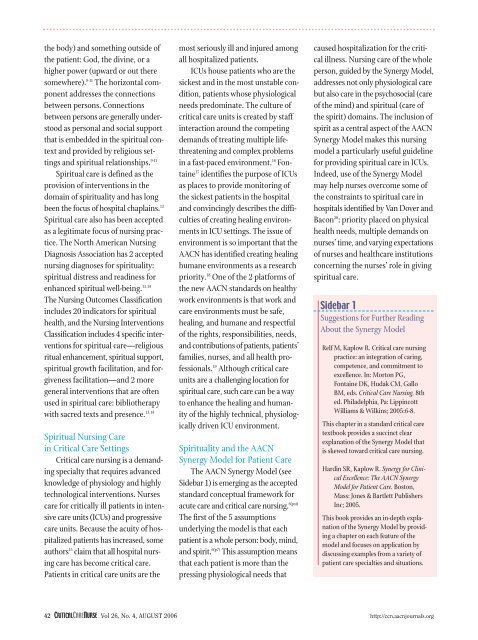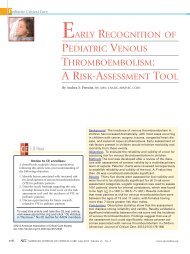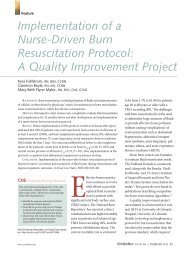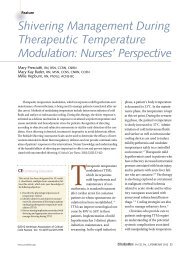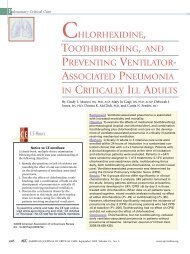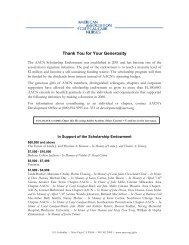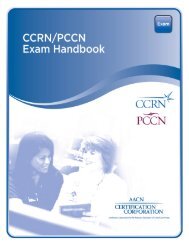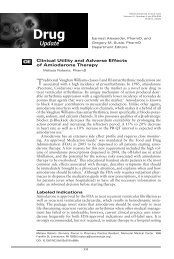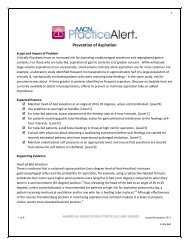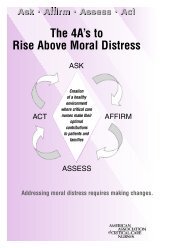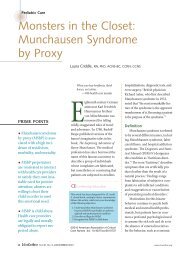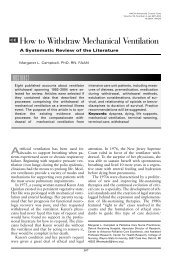Using the Synergy Model to Provide Spiritual Nursing Care in ...
Using the Synergy Model to Provide Spiritual Nursing Care in ...
Using the Synergy Model to Provide Spiritual Nursing Care in ...
Create successful ePaper yourself
Turn your PDF publications into a flip-book with our unique Google optimized e-Paper software.
<strong>the</strong> body) and someth<strong>in</strong>g outside of<br />
<strong>the</strong> patient: God, <strong>the</strong> div<strong>in</strong>e, or a<br />
higher power (upward or out <strong>the</strong>re<br />
somewhere). 9-11 The horizontal component<br />
addresses <strong>the</strong> connections<br />
between persons. Connections<br />
between persons are generally unders<strong>to</strong>od<br />
as personal and social support<br />
that is embedded <strong>in</strong> <strong>the</strong> spiritual context<br />
and provided by religious sett<strong>in</strong>gs<br />
and spiritual relationships. 9-11<br />
<strong>Spiritual</strong> care is def<strong>in</strong>ed as <strong>the</strong><br />
provision of <strong>in</strong>terventions <strong>in</strong> <strong>the</strong><br />
doma<strong>in</strong> of spirituality and has long<br />
been <strong>the</strong> focus of hospital chapla<strong>in</strong>s. 12<br />
<strong>Spiritual</strong> care also has been accepted<br />
as a legitimate focus of nurs<strong>in</strong>g practice.<br />
The North American <strong>Nurs<strong>in</strong>g</strong><br />
Diagnosis Association has 2 accepted<br />
nurs<strong>in</strong>g diagnoses for spirituality:<br />
spiritual distress and read<strong>in</strong>ess for<br />
enhanced spiritual well-be<strong>in</strong>g. 13,14<br />
The <strong>Nurs<strong>in</strong>g</strong> Outcomes Classification<br />
<strong>in</strong>cludes 20 <strong>in</strong>dica<strong>to</strong>rs for spiritual<br />
health, and <strong>the</strong> <strong>Nurs<strong>in</strong>g</strong> Interventions<br />
Classification <strong>in</strong>cludes 4 specific <strong>in</strong>terventions<br />
for spiritual care—religious<br />
ritual enhancement, spiritual support,<br />
spiritual growth facilitation, and forgiveness<br />
facilitation—and 2 more<br />
general <strong>in</strong>terventions that are often<br />
used <strong>in</strong> spiritual care: biblio<strong>the</strong>rapy<br />
with sacred texts and presence. 13,14<br />
<strong>Spiritual</strong> <strong>Nurs<strong>in</strong>g</strong> <strong>Care</strong><br />
<strong>in</strong> Critical <strong>Care</strong> Sett<strong>in</strong>gs<br />
Critical care nurs<strong>in</strong>g is a demand<strong>in</strong>g<br />
specialty that requires advanced<br />
knowledge of physiology and highly<br />
technological <strong>in</strong>terventions. Nurses<br />
care for critically ill patients <strong>in</strong> <strong>in</strong>tensive<br />
care units (ICUs) and progressive<br />
care units. Because <strong>the</strong> acuity of hospitalized<br />
patients has <strong>in</strong>creased, some<br />
authors 15 claim that all hospital nurs<strong>in</strong>g<br />
care has become critical care.<br />
Patients <strong>in</strong> critical care units are <strong>the</strong><br />
most seriously ill and <strong>in</strong>jured among<br />
all hospitalized patients.<br />
ICUs house patients who are <strong>the</strong><br />
sickest and <strong>in</strong> <strong>the</strong> most unstable condition,<br />
patients whose physiological<br />
needs predom<strong>in</strong>ate. The culture of<br />
critical care units is created by staff<br />
<strong>in</strong>teraction around <strong>the</strong> compet<strong>in</strong>g<br />
demands of treat<strong>in</strong>g multiple lifethreaten<strong>in</strong>g<br />
and complex problems<br />
<strong>in</strong> a fast-paced environment. 16 Fonta<strong>in</strong>e<br />
17 identifies <strong>the</strong> purpose of ICUs<br />
as places <strong>to</strong> provide moni<strong>to</strong>r<strong>in</strong>g of<br />
<strong>the</strong> sickest patients <strong>in</strong> <strong>the</strong> hospital<br />
and conv<strong>in</strong>c<strong>in</strong>gly describes <strong>the</strong> difficulties<br />
of creat<strong>in</strong>g heal<strong>in</strong>g environments<br />
<strong>in</strong> ICU sett<strong>in</strong>gs. The issue of<br />
environment is so important that <strong>the</strong><br />
AACN has identified creat<strong>in</strong>g heal<strong>in</strong>g<br />
humane environments as a research<br />
priority. 18 One of <strong>the</strong> 2 platforms of<br />
<strong>the</strong> new AACN standards on healthy<br />
work environments is that work and<br />
care environments must be safe,<br />
heal<strong>in</strong>g, and humane and respectful<br />
of <strong>the</strong> rights, responsibilities, needs,<br />
and contributions of patients, patients’<br />
families, nurses, and all health professionals.<br />
19 Although critical care<br />
units are a challeng<strong>in</strong>g location for<br />
spiritual care, such care can be a way<br />
<strong>to</strong> enhance <strong>the</strong> heal<strong>in</strong>g and humanity<br />
of <strong>the</strong> highly technical, physiologically<br />
driven ICU environment.<br />
<strong>Spiritual</strong>ity and <strong>the</strong> AACN<br />
<strong>Synergy</strong> <strong>Model</strong> for Patient <strong>Care</strong><br />
The AACN <strong>Synergy</strong> <strong>Model</strong> (see<br />
Sidebar 1) is emerg<strong>in</strong>g as <strong>the</strong> accepted<br />
standard conceptual framework for<br />
acute care and critical care nurs<strong>in</strong>g. 6(pxi)<br />
The first of <strong>the</strong> 5 assumptions<br />
underly<strong>in</strong>g <strong>the</strong> model is that each<br />
patient is a whole person: body, m<strong>in</strong>d,<br />
and spirit. 6(p7) This assumption means<br />
that each patient is more than <strong>the</strong><br />
press<strong>in</strong>g physiological needs that<br />
caused hospitalization for <strong>the</strong> critical<br />
illness. <strong>Nurs<strong>in</strong>g</strong> care of <strong>the</strong> whole<br />
person, guided by <strong>the</strong> <strong>Synergy</strong> <strong>Model</strong>,<br />
addresses not only physiological care<br />
but also care <strong>in</strong> <strong>the</strong> psychosocial (care<br />
of <strong>the</strong> m<strong>in</strong>d) and spiritual (care of<br />
<strong>the</strong> spirit) doma<strong>in</strong>s. The <strong>in</strong>clusion of<br />
spirit as a central aspect of <strong>the</strong> AACN<br />
<strong>Synergy</strong> <strong>Model</strong> makes this nurs<strong>in</strong>g<br />
model a particularly useful guidel<strong>in</strong>e<br />
for provid<strong>in</strong>g spiritual care <strong>in</strong> ICUs.<br />
Indeed, use of <strong>the</strong> <strong>Synergy</strong> <strong>Model</strong><br />
may help nurses overcome some of<br />
<strong>the</strong> constra<strong>in</strong>ts <strong>to</strong> spiritual care <strong>in</strong><br />
hospitals identified by Van Dover and<br />
Bacon 20 : priority placed on physical<br />
health needs, multiple demands on<br />
nurses’ time, and vary<strong>in</strong>g expectations<br />
of nurses and healthcare <strong>in</strong>stitutions<br />
concern<strong>in</strong>g <strong>the</strong> nurses’ role <strong>in</strong> giv<strong>in</strong>g<br />
spiritual care.<br />
Sidebar 1<br />
Suggestions for Fur<strong>the</strong>r Read<strong>in</strong>g<br />
About <strong>the</strong> <strong>Synergy</strong> <strong>Model</strong><br />
Relf M, Kaplow R. Critical care nurs<strong>in</strong>g<br />
practice: an <strong>in</strong>tegration of car<strong>in</strong>g,<br />
competence, and commitment <strong>to</strong><br />
excellence. In: Mor<strong>to</strong>n PG,<br />
Fonta<strong>in</strong>e DK, Hudak CM, Gallo<br />
BM, eds. Critical <strong>Care</strong> <strong>Nurs<strong>in</strong>g</strong>. 8th<br />
ed. Philadelphia, Pa: Lipp<strong>in</strong>cott<br />
Williams & Wilk<strong>in</strong>s; 2005:6-8.<br />
This chapter <strong>in</strong> a standard critical care<br />
textbook provides a succ<strong>in</strong>ct clear<br />
explanation of <strong>the</strong> <strong>Synergy</strong> <strong>Model</strong> that<br />
is skewed <strong>to</strong>ward critical care nurs<strong>in</strong>g.<br />
Hard<strong>in</strong> SR, Kaplow R. <strong>Synergy</strong> for Cl<strong>in</strong>ical<br />
Excellence: The AACN <strong>Synergy</strong><br />
<strong>Model</strong> for Patient <strong>Care</strong>. Bos<strong>to</strong>n,<br />
Mass: Jones & Bartlett Publishers<br />
Inc; 2005.<br />
This book provides an <strong>in</strong>-depth explanation<br />
of <strong>the</strong> <strong>Synergy</strong> <strong>Model</strong> by provid<strong>in</strong>g<br />
a chapter on each feature of <strong>the</strong><br />
model and focuses on application by<br />
discuss<strong>in</strong>g examples from a variety of<br />
patient care specialties and situations.<br />
42 CRITICALCARENURSE Vol 26, No. 4, AUGUST 2006 http://ccn.aacnjournals.org


